Japanese Pollia likes the shady and humid environment under the forest. In this environment, there is also a common plant in Taiwan: Amischotolype hispida of the same family. Its leaf shape and size are very similar to this species, and they all have amplexicaul leaf sheaths. The inflorescence of Amischotolype hispida is many flowers clustered on the stem nodes, and this species is terminal, with a long inflorescence peduncle extending far from the top of the plant, which is the easiest way to distinguish between the two. If the plant is not blooming, you can touch the leaf surface to see, the upper surface of the leaves of Amischotolype hispida is smooth and hairless, and the fingers can easily slide, unlike this species' sandpaper-like top surface.
Japanese Pollia
(2017.6.10 Taiwan)
About Japanese Pollia
| ◆ | Classification: Genus Pollia; Family Commelinaceae | |
| ◆ | Scientific name: Pollia japonica Thunb | |
| ◆ | English Name: Japanese Pollia | |
| ◆ | Chinese name: 杜若、山薑、中國水竹葉、石竹菜、地藕、竹葉蓮、山竹殼菜、燕子花 | |
| ◆ | Origin: Southern China, Japan, Korea, Taiwan | |
| ◆ | Growth environment in Taiwan: Shady and humid places under broad-leaved forests from the middle and northern Taiwan, at an altitude of 300 to 1000 m | |
| ◆ | Growth habit: Perennial herb | |
| ◆ | Maximum Height: About 30 to 90 cm | |
| ◆ | Rhizome & stem: Rhizomes on the ground long and creeping, with joints, often rooting at the joints; stems erect or ascending, about 30-100 cm long, 0.3-0.8 cm in diameter, puberulent, scabrous | |
| ◆ | Leaf | |
| 》 | Simple leaf, opposite, often at the top of the stem, rough chartaceous, narrowly elliptic, base cuneate, apex acuminate, entire, margin often undulate | |
| 》 | Leaf blade about 10-30 cm long, 3-7 cm broad | |
| 》 | Sessile or base attenuate into winged petiole; leaf sheaths glabrous, amplexicaul | |
| 》 | Upper surface dark green, densely covered with coarse hairs, rough; lower surface light green, covered with hook hairs | |
| 》 | Pinnate veins, lateral veins nearly parallel, indistinct | |
| ◆ | Flower | |
| 》 | Bisexual, hypogyny; helicoid cyme or panicle cyme, often in several distant whorls; peduncle can reach 15-30 cm long, puberulent; involucre lanceolate or narrow ovate | |
| 》 | Pedicel white, about 0.2-0.4 cm long; bract membranous | |
| 》 | Sepals 3, ovate-orbicular, ca. 0.3cm long, glabrous, persistent | |
| 》 | Petals 3, obovate-spatulate, ca. 0.3cm long | |
| 》 | Stamens 6, all fertile, filament long, white | |
| 》 | Pistil carpel 3, united; style white, long, stigma capitate at tip | |
| ◆ | Fruit & seed: Capsule globose, polished, ca. 0.5-0.7 cm in diameter, 3 locule, blue-black when ripe. Seeds 5-8 per locule, pitchy, shape irregular | |
Japanese Pollia is a native plant in Taiwan. It is distributed in the central and northern area at an altitude of 300 to 1000 meters, grows in shady and humid places under broad-leaved forests.
Japanese Pollia
(2017.6.10 Taiwan)
It is a perennial herb with a plant height of about 30 to 90 cm.
Japanese Pollia
(2022.9.30 Taiwan)
It has underground creeping rhizomes.
The rhizome of Japanese Pollia
(2022.11.17 Taiwan)
Stems are erect or ascending, about 30-100 cm long, 0.3-0.8 cm in diameter, puberulent and scabrous.
The stems and roots of Japanese Pollia
(2022.9.30 Taiwan)
One to several long rhizomes often grow at the nodes of the base of the stem.
The rhizome of Japanese Pollia
(2017.6.10 Taiwan)
Rhizomes on the ground are long and creeping, with joints and often rooting at the joints.
The rhizome of Japanese Pollia
(2017.6.10 Taiwan)
The rhizome of Japanese Pollia
(2017.6.10 Taiwan)
It has opposite simple leaf and often at the top of the stem.
The phyllotaxy of Japanese Pollia
(2017.6.10 Taiwan)
Leaves are sessile or base attenuate into winged petiole; leaf sheaths are glabrous and amplexicaul.
The leaf sheath of Japanese Pollia
(2022.9.30 Taiwan)
Leaves are rough chartaceous, narrowly elliptic, cuneate at base and cuminate at apex, margin entire and often undulate. Leaf blade is about 10-30 cm long and 3-7 cm broad.
The leaves of Japanese Pollia
(2022.9.30 Taiwan)
Upper surface of the leaf is dark green, rough and densely covered with fine and coarse hairs. The hairs are too small to be seen with the naked eyes, even with a macro camera, but it can be felt by touching it with hands. When you touch it and try to slide lightly, it looks like your finger is stuck, you feel it is like a piece of very fine sandpaper..
The leaves of Japanese Pollia (upper surface)
(2022.11.17 Taiwan)
Lower surface of the leaf is light green and covered with hook hairs.
The leaves of Japanese Pollia (lower surface)
(2022.9.30 Taiwan)
Flowers are bisexual. Inflorescences are helicoid cyme or panicle cyme, often in several distant whorls.
The inflorescence of Japanese Pollia
(2017.6.10 Taiwan)
The peduncle can reach 15-30 cm long and it is puberulent.
The inflorescence of Japanese Pollia
(2017.6.10 Taiwan)
The involucre is lanceolate or narrow ovate.
The involucre and peduncle of Japanese Pollia
(2018.7.18 Taiwan)
The pedicel is white and about 0.2-0.4 cm long. The bract is membranous.
Flowers of Japanese Pollia
(2017.6.10 Taiwan)
The corolla is campanulate.
Sepals 3, ovate-orbicular, about 0.3cm long, glabrous, persistent.
Petals 3, obovate-spatulate, about 0.3cm long.
Flowers of Japanese Pollia
(2018.7.18 Taiwan)
Stamens 6, all fertile, filament long and white.
Flowers of Japanese Pollia
(2017.6.10 Taiwan)
Pistil carpel 3, united; style is white and long, stigma is capitate at tip.
杜若的花
(2018.7.18 Taiwan)
Its fruit is a capsule.
Capsules of Japanese Pollia
(2022.9.30 Taiwan)
The capsules are globose and polished.
Capsules of Japanese Pollia
(2022.11.17 Taiwan)
The capsules are about 0.5-0.7 cm in diameter, 3 locule, blue-black when ripe.
Capsules of Japanese Pollia
Seeds are pitchy and with irregular shape. (The picture below are seeds in one capsule.)
Seeds of Japanese Pollia

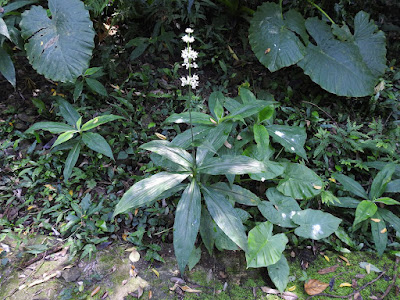

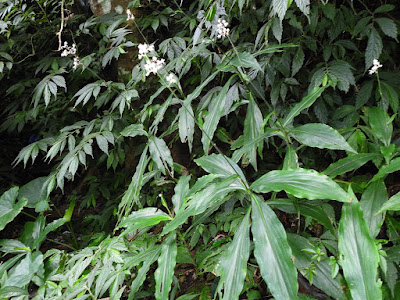
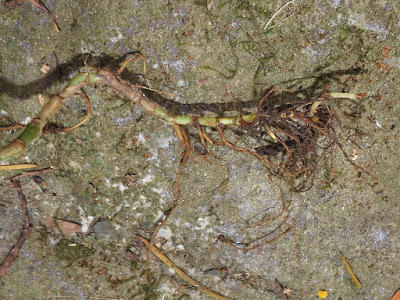
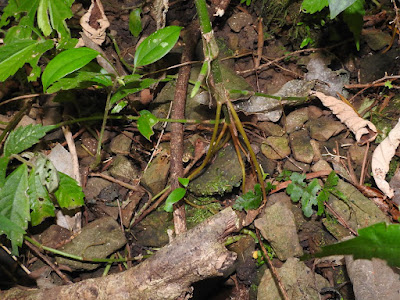

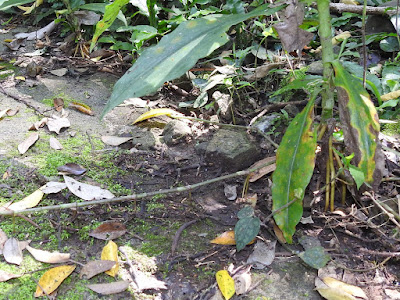
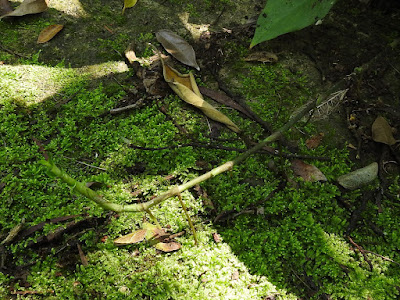

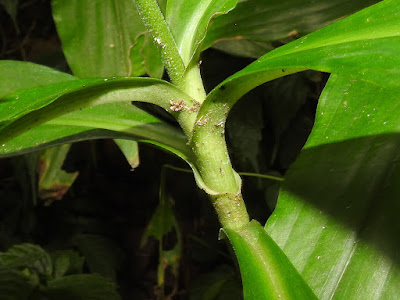
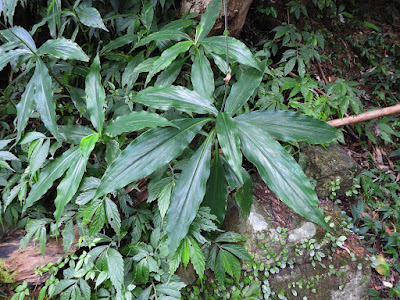

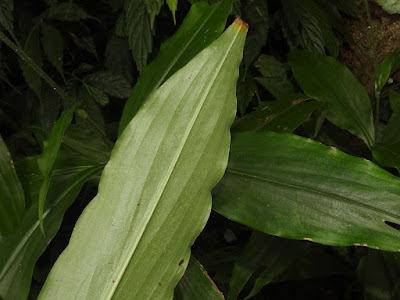
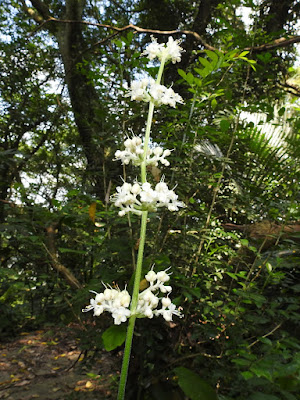

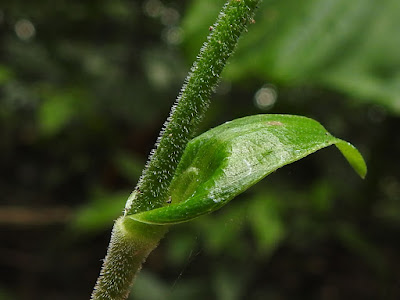
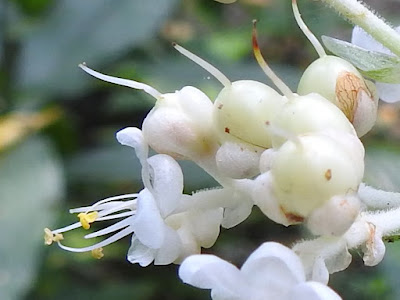

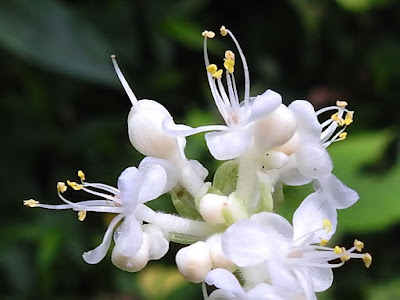



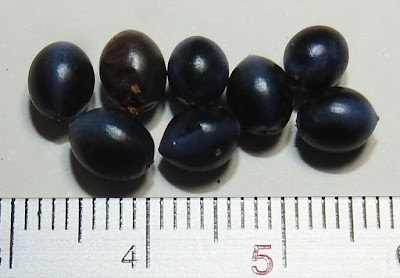

沒有留言:
張貼留言